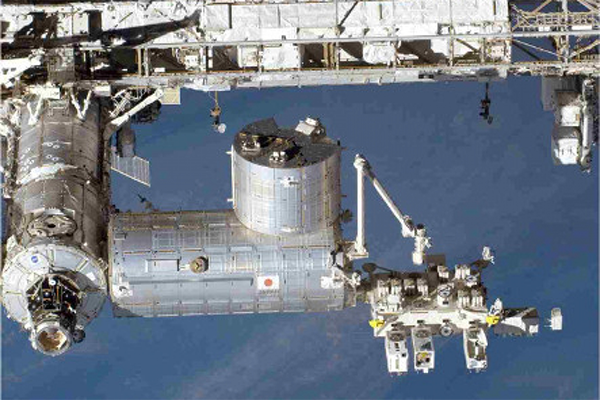O Ariadni Et Al Physical Review Letters 119 181101 2017
CALET Makes Commencement Direct Measurements of High Free energy Electrons in Infinite

ISS showing the Japanese Experiment Module – External Facility (JEM-EF).Photo Credit: JAXA
CALET's Measurements Move Astrophysicists a Pace Closer to Understanding the Origin and Dispatch of Catholic Rays
The CALET Cosmic Ray experiment, led by Professor Shoji Torii from Waseda University in Nippon, along with collaborators from LSU and other researchers in the U.Due south. and abroad, have successfully carried out the high-precision measurement of cosmic-ray electron spectrum up to three tera electron volts (TeV) by using the CALorimetric Electron Telescope (CALET) on the Japanese Experimental Module, the Exposed Facility on the International Infinite Station (ISS). This experiment is the starting time to make direct measurements of such high free energy electrons in infinite.
The CALET squad published its start results in Concrete Review Letters Nov 1
(O. Ariadne et al., Physical Review Letters 119, 181101, 2017).
The CALET experiment is funded past the Japanese Space Agency (JAXA), the Italian Space Bureau (ASI), and NASA. John Wefel, professor emeritus in LSU'south Department of Physics & Astronomy, serves as the spokesperson for the U.S. CALET team, which includes LSU (lead U.S. institution), NASA Goddard Space Flight Centre, Washington University, and the University of Denver. Other LSU researchers working with the project are PhD pupil Nick Cannady, inquiry assembly Doug Granger and Amir Javaid, onetime LSU undergraduate Anthony Ficklin, and professors of physics and astronomy Greg Guzik and Mike Ruby.
"Loftier energy electrons are difficult to measure out, simply important because they potentially provide information nigh nearby astrophysical sources of high energy radiation and/or dark thing," said Cherry-red. "The initial results provide a hint of anticipated structure in the high energy spectrum, which may signal the presence of a nearby source of high energy particles similar a pulsar or the annihilation of dark thing."
CALET was installed on the ISS in August 2015 and has been accumulating scientific data since Oct 2015 with a goal of 5 years of operation. CALET is the first Japanese-led space-based mission defended to cosmic ray observations.
The origin and acceleration of cosmic rays are notwithstanding 1 of the cosmic mysteries, and cosmic-ray electrons are ane of the near important targets of high-energy cosmic ray research. Yet, in gild to observe high-free energy electrons, it is required to accept (ane) high-precision energy measurement of each cosmic ray particle, (ii) sensitivity to detect the very rare electron flux, and (3) the capability to identify electrons buried under the over 1,000 times college flux of cosmic ray protons. Thus the measurement of electrons above i TeV has been a difficult goal to accomplish. The calorimeter of CALET, with its unique and crucial capabilities, enables scientists to perform authentic measurement of cosmic-ray electrons into the TeV region thank you to the long-term exposure available on the ISS.
This measurement demonstrates the ability of CALET to practise a precise directly measurement of electrons above 1 TeV that was difficult for by experiments. With five years of observations, CALET volition reach nearly 6 times higher statistics compared to this offset effect, and volition allow for reduction of the systematic uncertainties, including that from the detector response. The goal of the project is to button the energy limit to 20 TeV and to obtain the precise free energy spectrum, hopefully making it possible to demonstrate definitively the presence of nearby astrophysical catholic ray sources and/or to reveal the nature of nighttime matter.
For additional data well-nigh the science, encounter the CALET spider web site at http://calet.phys.lsu.edu and the NASA and JAXA press releases institute in that location.
Contacts:
Faculty of Science and Engineering science, Waseda Academy:
Professor Shoji Torii, Inquiry Scientist Yoichi Asaoka
Tel: 03-5286-3090 | Eastward-mail service: torii.shoji@waseda.jp, yoichi.asaoka@aoni.waseda.jp
Faculty of Physics & Astronomy, Louisiana State University:
Roy P. Daniels Professor Mike Cherry | Tel: 225-578-8591 | Email: cherry@lsu.edu
Professor Greg Guzik | Tel: 225-578-8597 | Email:guzik@phunds.phys.lsu.edu
Source: https://www.lsu.edu/science/news_events/cos-news-events/CALETFirst.php
0 Response to "O Ariadni Et Al Physical Review Letters 119 181101 2017"
Post a Comment